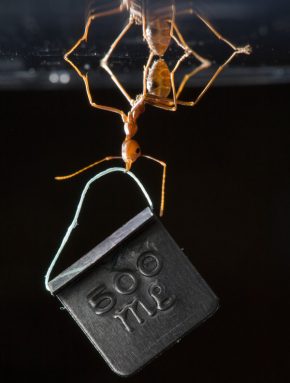These ants boast mighty grip
Strong sticking power and quick reaction time helps them hold onto trees
By Susan Milius

Asian weaver ants boast not one but two superpowers: an extremely good grasp and a super quick backup strategy to keep from losing that grip during emergencies. Researchers reported their new findings in a scientific journal on February 27.
These ants nest in trees. Tumbling out will not usually hurt these insects. Their bigger danger from falling would be the risk of not finding their long way back to the nest. Fortunately, these ants can walk securely, even when traveling upside down. To do this, the insects’ foot pads tightly grasp onto branches or leaves. But an ant must also be able to change its grip in an instant. For example, an ant must let go to take its next step. And the bug must increase its grip when winds shake up its world.
How do these critters manage to keep their grip — especially when their footing gets shaky? To find out, researchers studied high-speed video recordings of the tiny animals’ even tinier feet.
The ants’ foot pads are moist. But that moisture isn’t a glue, explains Thomas Endlein of Scotland’s University of Glasgow. The moisture instead allows those foot pads to hold fast using capillary action. This is the same natural process that allows a water-soaked paper towel to cling to a window.
And when the footing gets especially shaky, an ant’s foot pads can more than double in size. But that expansion does not occur equally in all directions, report Endlein and Walter Federle of the University of Cambridge in England. The foot pads’ increased contact with the surface balloons out more to the sides. Bigger foot pads grip better.
Although ants have other ways of stretching out their foot pads, those are slower. This one kicks in within an instant — but only when ants need it most.
The foot pads’ expansion occurs within a millisecond of when a surface starts shaking. That’s five to 10 times faster than the speediest known nerve responses. So this boosted grip response must be mechanical, the researchers conclude. That would mean it was not due either to biological or chemical reactions. Endlein and Federle describe their findings online in the Proceedings of the Royal Society B.
Power Words
capillary action This is the force that governs the movement of a liquid along the surface of a solid. Because molecules of the liquid are attracted to the surface and to each other, they can pull each other along. Capillary action explains how sponges wick up liquids.
glue A sticky substance that attaches one material to another.







